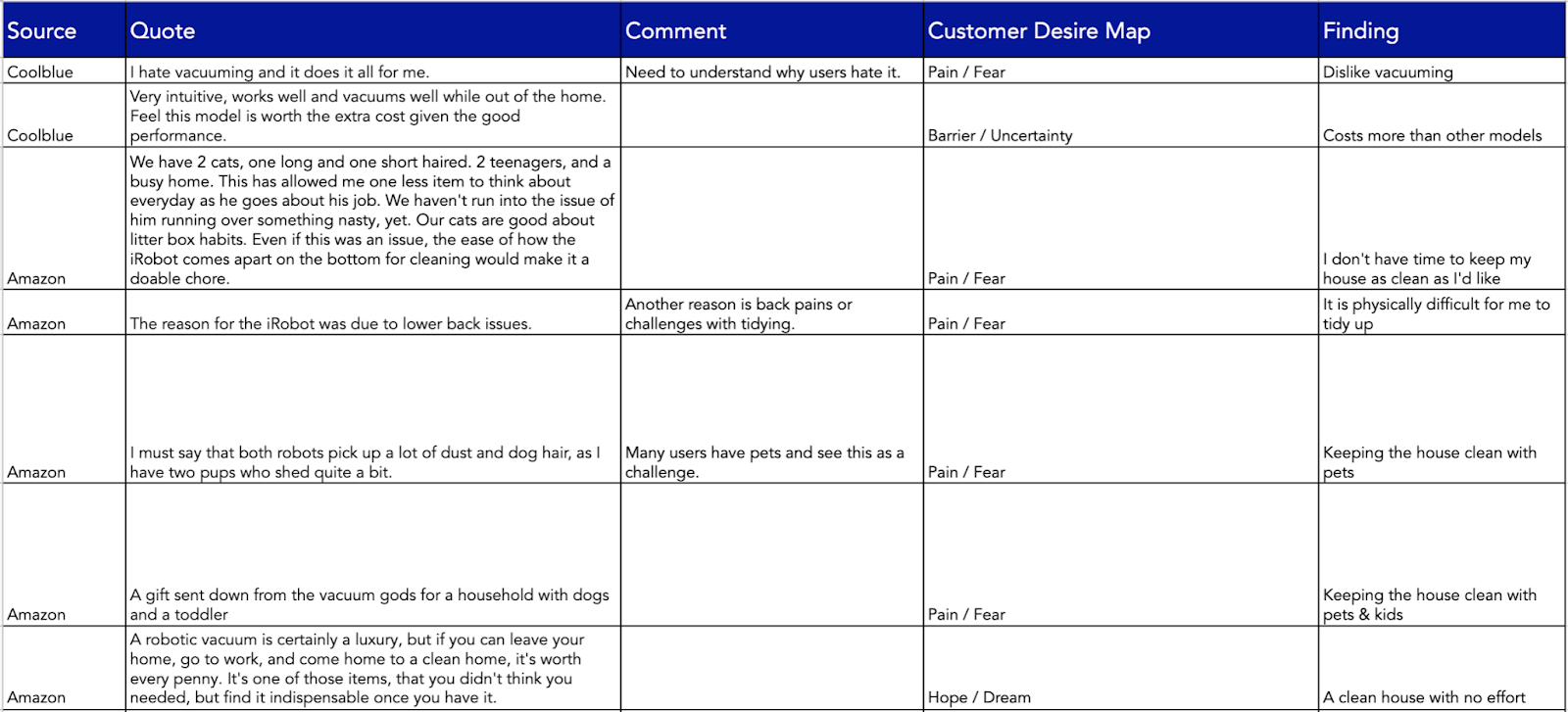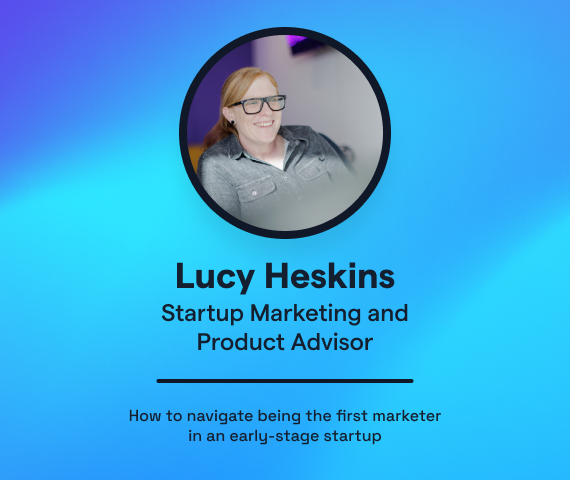How to write copy that converts… by stealing copy
The new science to writing killer copy
When it comes to writing copy for our customers, people try to get all creative—devising catchy phrases or clever puns… that probably only they will get.
We do our utmost best to trigger our potential customers into action, yet too often our brilliantly thought-out copy plain flops.
Copy can be so powerful, but how do you make sure it converts?
That it speaks to your customer, pinpoints their specific pain AND also offers them a solution?
All that with super limited characters because you need to use it for all types of ad copy?
Does this sound a bit impossible?
Don’t worry; it isn’t with one clever trick.
I believe we make writing copy far too hard for ourselves. We make it a 100% creative art rather than a science. We want to be the one who invents and creates it, who comes up with those tantalising triggering words. Yet, we have a saying in Dutch:
“Beter goed gejat dan slecht verzonnen.”
Which roughly translates to:
“Better to cleverly steal rather than badly improvised.”
Yup, I am saying it, the bold claim in the title of this article: good copy is stolen.
So, where do you steal it from? Right out of the mouths of your customers.
We are writing for our customers, not for our ego. And who knows better how our customers feel and talk than, well, our customers? As with so much in marketing and growth hacking, it all comes down to listening to your customers.
I have tested this for website copy, e-mail copy and ad copy. In 95% of cases, the ‘stolen’ copy wins from what we wrote ourselves. I was a growth consultant for 5+ years so I know this works across different client types.
I usually see at least 20% – 50% higher click-through rate on ads when I use this technique for my copy versus the standard copy used before. Not only that, it saves me hours in the long run in trying to craft copy.
Now let’s make this super concrete. How do you transform your customers’ words into killer converting copy?
By the end of this article, you will know exactly the step-by-step process to do so. Even better: if you follow along with me, you will have it all set up by the end of this article.
Ready? Let’s start stealing. I mean… creating.
Step 1: Get your mining caps on and start digging
Luckily customers like to talk; we have such a wealth of data about our customers’ thanks to the internet. If they aren’t talking about our product or company, they will usually talk about a similar product or your competitor.
Good places to strike gold are:
- Review websites e.g. Google Reviews, Trustpilot, etc.
- Forums, e.g. Quora, Reddit
- Social Media
- Amazon or other webshops
And if all else fails, try asking them via a survey (Just don’t be an Askhole and ask loads but do nothing with those insights).
Find a place where your customer is leaving their opinion (good and bad) about your product/service. Then grab an excel and set it up as follows:

Excel template, feel free to copy the following Google Sheet.
Sometimes it can be helpful to add other information:
- A link to where the original review is or additional information
- Which product/service they used (if you have multiple)
- Purchase frequency
- Any other relevant information about whom the individual is (if that is available)
Start reading through the reactions on the source of your choice and add the ones that trigger (aka not “Great product!”) into the Google Sheet or Excel.
For now, just add any review that gives you an idea of why the user bought the product, what they feel about the product, etc. Don’t fill in the 4th and 5th columns for now (the Customer Desire Map and Finding).
I usually find that between 50 – 100 reviews give me all the insights I need for building one customer desire map. So try to aim for at least 50 reviews, but feel free to stop earlier if they are just getting repetitive.
I decided to show you how to do this with an actual product: iRobot Roomba 960 Robot Vacuum. A secret dream of mine is to get one of these. The idea of not vacuuming, heaven!
Here are the first few I came across:

Overview of quotes filled in
I started looking for reviews on Coolblue (a Dutch electronics brand), but they only had a few English. Then I hit the jackpot on Amazon. Believe it or not: people write 1,000+ words about a robot vacuum!
I am not kidding; I was fascinated. In less than an hour, I had 25 reviews in my template. I didn’t include the whole life stories but included the parts that stood out to me. I also added some quick notes about trends I noticed.
I learned a lot about robot vacuums, not just about the customer’s deeper desires:
- People name their Robot Vacuum and not just by affectionately referring to it as ‘Little Guy’, but Rick, Scooter and Scoozy are all Robot Vacuum names.
- Pets or kids seem to be a key reason people get them, that or back pain.
- Users often use them: almost daily (apparently, I’m not vacuuming enough, another good reason to get one).
- People have a weird disgust/delight about just how much it picks up.
I think this is going to be an expensive article, the more I read, the more I wanted one.
Step 2: Identify what types of gold you found
The next step is to split the reviews into three types based on which part of the Customer Desire Map (CDM) they relate to:
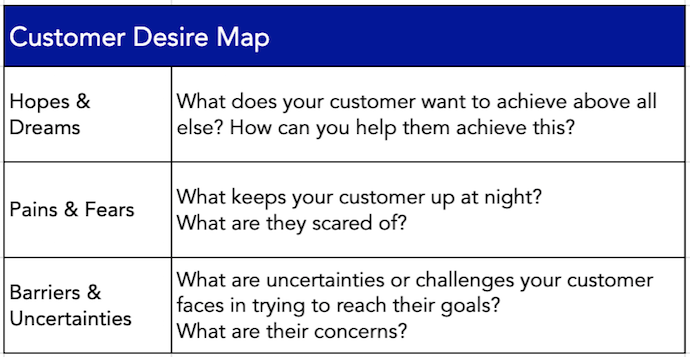
The Customer Desire Map Framework
I always think of it as if you are trying to get from A to B:
- A is where you are now, your Pains & Fears.
- B is where you want to go, your Hopes & Dreams.
- Barriers & Uncertainties are what stands in your way.
Barriers and uncertainties make it harder for you to get from A to B; they are that little voice in your mind that nags you while thinking about making a purchase. “Do you need this? What if it doesn’t work the way you’d hope?”
The idea is you can use your CDM as input for writing copy. You can show your customer that you understand the pain/fear they struggle with, that you can help solve it, and no, don’t worry one bit about the carpet to hardwood transition in your house; Scooter is going to nail that.
Now that you have got the theory, it is time to go through your quotes and start dividing them into three piles.
For each quote,, indicate which of the three areas of the Customer Desire Map it relates to and what you feel is the underlying hope/pain/barrier (the Finding column). We aren’t aiming for perfection here; we can formulate the sentences better later on. Just try to understand our users and spot recurring patterns.
Quotes labelled according to Customer Desire Map.
Sometimes a quote will show two different areas, like quote 4 in the image above. Rather than merging the quote over two rows, just copy and paste it to display it twice or split it up. You want to sort it by Customer Desire Map later on, and pro tip: that doesn’t work well with merge fields (I learnt that the hard way).
Step 3: Organising your gold further
Now that you’ve categorised all your reviews, you can start setting up your Customer Desire Map. You can either add the literal quotes as or have two:
- Your findings
- The quotes per area
I like to split them into two to keep the overview clean. Then one becomes my deep dive in the head of the customer, and the other my copy ‘swipe’ file.
For the CDM of someone wanting an iRobot Roomba 960 Robot Vacuum, aka Scooter, I have set up one overall customer desire map. If you have various personas, you could set up one CDM per persona.
I don’t know enough about Scooters to know which personas they have. Based on the reviews, I could imagine separating pet owners from older individuals with back pain or physical challenges from pet owners as they are very different use cases with different CDMs.
For now, I will just set up an overall Customer Desire Map for people looking for a Roomba. I sorted the table by the Customer Desire Map column so that I could easily walk through all the Hopes and Dreams and started picking out patterns. Then I did the same for the Pains and Fears and finally Barriers and Uncertainties. I like to write my CDM in the first person as the goal is to understand the target audience, not to say, “Customer struggles with different surfaces within their house”.
Here is my deep dive CDM for Scooter:
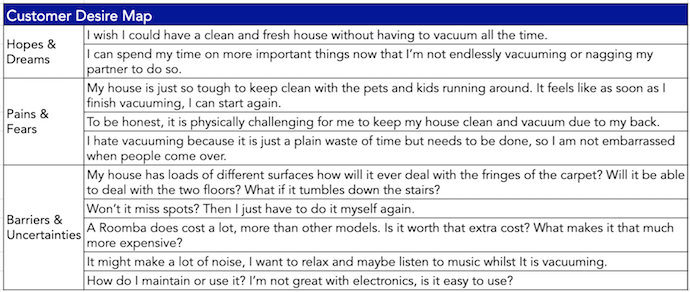
Overall filled in Customer Desire Map for the Roomba
When setting up a CDM, keep asking why. With everything you write, try to dig a step deeper. So “I hate vacuuming” is too high-level by itself.
You want to understand why someone hates it; what is the reason behind it?
As I realised reading the reviews, it often came down to the following: it was seen as a waste of time or was physically challenging.
Next up, the quote overview; here is my example:
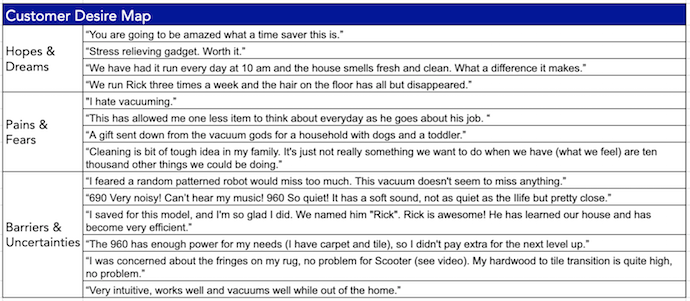
Quotes Customer Desire Map for the Roomba
Step 4: Selling your gold – Stolen Copy in Action
Now we are getting somewhere. In just a few hours, you should have a CDM and the exact language of your customer to describe those products. Let’s say I have a vacuum store, and I want to sell Roombas (Not Scooter, I’m keeping Scooter). I can now use this copy to trigger users:
Does it feel like you need to vacuum every day with all your kids and pets constantly running around? Does it feel like you are endlessly trying to keep everything clean? Never stress again about keeping your house clean and fresh with the iRobot Roomba 960 Robot Vacuum.
This robot vacuum is made to keep every house clean, whether you have two floors or different surfaces. Whilst you spend time relaxing, this little guy will quietly scour your home and remove every hair and dust. Just press “Clean”, let him find his way around, and you will have one less thing to worry about every day.
Now I’m not saying the copy above is perfect, but it is, in my opinion, already better than the description I found online:

Source: Amazon
This only tells about the benefits & features of the robot, not what pain it is solving. Also, what the hell is airpower?
In our new copy (freshly lifted from the end-user), we help the user first identify with the challenges of keeping a house clean; it makes it relatable. What if you never had to stress about that again or waste time? Intrigued?
We introduce the product to them and then remove some doubts (But I have two floors? Or what if it misses spots? Is it easy to use?). Again driving the dream of you could have one less thing to worry about. It is very personal, talking about “you” rather than mechanical copy about how it’s a great product and its fancy features.
Ready to start stealing?
Now you know way too much about Robot Vacuums and how to steal a copy, I hope you are ready to give it a go that you will create powerful copy that resonates.
At Heights we have a 1,000+ swipe file that we’ve created over time. Whenever we write any copy, we go first to the raw data and customer desire map. We try to always use the customers’ words rather than our own, even for the small things. Does our target audience say they suffer from brain fog or feel foggy? Check the swipe file.
This is such a powerful technique to get into your customers’ minds and write better copy faster. Let’s encourage this type of stealing and create a beautiful customer-centric copy.
Let me know how it goes, and in the meantime, I am off to buy myself my very own Robot Vacuum.
